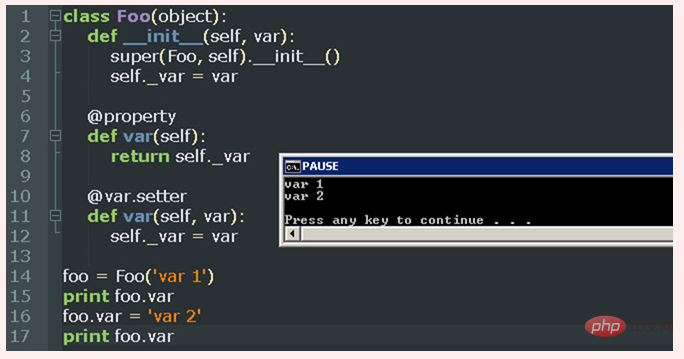python 裝飾器詳解

python裝飾器詳解
#python裝飾器的詳細解析
什麼是裝飾器?
推薦學習:Python影片教學
python裝飾器(fuctional decorators)就是用來拓展原來函數功能的函數,目的是在不改變原函數名(或類別名稱)的情況下,為函數增加新的功能。
這個函數的特別之處在於它的回傳值也是一個函數,這個函數是內嵌「原「」函數的函數。
一般而言,我們要拓展原來函數程式碼,最直接的辦法就是侵入程式碼裡面修改,例如:
import time
def f():
print("hello")
time.sleep(1)
print("world")
#這是我們最原始的的函數,然後我們試著記錄這個函數執行的總時間,那最簡單的做法就是改動原來的程式碼:
import time
def f():
start_time = time.time()
print("hello")
time.sleep(1)
print("world")
end_time = time.time()
execution_time = (end_time - start_time)*1000
print("time is %d ms" %execution_time)
但是實際工作中,有些時候核心程式碼並不可以直接去改,所以在不改動原始程式碼的情況下,我們可以再定義一個函數。(但是生效需要再次執行函數)
import time
def deco(func):
start_time = time.time()
f()
end_time = time.time()
execution_time = (end_time - start_time)*1000
print("time is %d ms" %execution_time)
def f():
print("hello")
time.sleep(1)
print("world")
if __name__ == '__main__':
deco(f)
print("f.__name__ is",f.__name__)
print()
#這裡我們定義了一個函數deco,它的參數是一個函數,然後給這個函數嵌入了計時功能。但是想要拓展這一千萬個函數功能,
就是要執行一千萬次deco()函數,所以這樣並不理想!接下來,我們可以試著用裝飾器來實現,先看看裝飾器最原始的面貌。
import time
def deco(f):
def wrapper():
start_time = time.time()
f()
end_time = time.time()
execution_time = (end_time - start_time)*1000
print("time is %d ms" %execution_time )
return wrapper
@deco
def f():
print("hello")
time.sleep(1)
print("world")
if __name__ == '__main__':
f()
這裡的deco函數就是最原始的裝飾器,它的參數是一個函數,然後傳回值也是一個函數。
其中作為參數的這個函數f()就在傳回函數wrapper()的內部執行。然後在函數f()前面加上@deco,
f()函數就相當於被注入了計時功能,現在只要呼叫f(),它就已經變身為「新的功能更多」的函數了,
(不需要重複執行原函數)。
擴展1:帶有固定參數的裝飾器
import time
def deco(f):
def wrapper(a,b):
start_time = time.time()
f(a,b)
end_time = time.time()
execution_time = (end_time - start_time)*1000
print("time is %d ms" % execution_time)
return wrapper
@deco
def f(a,b):
print("be on")
time.sleep(1)
print("result is %d" %(a+b))
if __name__ == '__main__':
f(3,4)擴展2:無固定參數的裝飾器
import time
def deco(f):
def wrapper(*args, **kwargs):
start_time = time.time()
f(*args, **kwargs)
end_time = time.time()
execution_time_ = (end_time - start_time)*1000
print("time is %d ms" %execution_time)
return wrapper
@deco
def f(a,b):
print("be on")
time.sleep(1)
print("result is %d" %(a+b))
@deco
def f2(a,b,c):
print("be on")
time.sleep(1)
print("result is %d" %(a+b+c))
if __name__ == '__main__':
f2(3,4,5)
f(3,4)
擴充3:使用多個裝飾器,裝飾一個函數
import time
def deco01(f):
def wrapper(*args, **kwargs):
print("this is deco01")
start_time = time.time()
f(*args, **kwargs)
end_time = time.time()
execution_time = (end_time - start_time)*1000
print("time is %d ms" % execution_time)
print("deco01 end here")
return wrapper
def deco02(f):
def wrapper(*args, **kwargs):
print("this is deco02")
f(*args, **kwargs)
print("deco02 end here")
return wrapper
@deco01
@deco02
def f(a,b):
print("be on")
time.sleep(1)
print("result is %d" %(a+b))
if __name__ == '__main__':
f(3,4)''' this is deco01 this is deco02 hello,here is a func for add : result is 7 deco02 end here time is 1003 ms deco01 end here '''
裝飾器呼叫順序
裝飾器是可以疊加使用的,那麼使用裝飾器以後代碼是啥順序呢?
對於Python中的”@”語法糖,裝飾器的呼叫順序與使用 @ 語法糖聲明的順序相反。
在這個例子中,」f(3, 4) = deco01(deco02(f(3, 4)))」。
Python內建裝飾器
在Python中有三個內建的裝飾器,都是跟class相關的:staticmethod、classmethod 和property 。
staticmethod 是類別靜態方法,其跟成員方法的區別是沒有self 參數,並且可以在類別不進行實例化的情況下調用
classmethod 與成員方法的區別在於所接收的第一個參數不是self (類別實例的指標),而是cls(目前類別的具體類型)
property 是屬性的意思,表示可以透過透過類別實例直接存取的資訊
對於staticmethod和classmethod這裡就不介紹了,透過一個例子來看看property。

注意,對於Python新式類別(new-style class),如果將上面的「@var.setter」 裝飾器所裝飾的成員函數去掉,則Foo. var 屬性為唯讀屬性,使用「foo.var = 'var 2′」 進行賦值時會拋出異常。但是,對於Python classic class,所宣告的屬性不是 read-only的,所以即使去掉」@var.setter」裝飾器也不會報錯。
總結
本文介紹了Python裝飾器的一些使用,裝飾器的程式碼還是比較容易理解的。只要透過一些例子進行實際操作一下,就很容易理解了。
以上是python 裝飾器詳解的詳細內容。更多資訊請關注PHP中文網其他相關文章!

熱AI工具

Undresser.AI Undress
人工智慧驅動的應用程序,用於創建逼真的裸體照片

AI Clothes Remover
用於從照片中去除衣服的線上人工智慧工具。

Undress AI Tool
免費脫衣圖片

Clothoff.io
AI脫衣器

Video Face Swap
使用我們完全免費的人工智慧換臉工具,輕鬆在任何影片中換臉!

熱門文章

熱工具

記事本++7.3.1
好用且免費的程式碼編輯器

SublimeText3漢化版
中文版,非常好用

禪工作室 13.0.1
強大的PHP整合開發環境

Dreamweaver CS6
視覺化網頁開發工具

SublimeText3 Mac版
神級程式碼編輯軟體(SublimeText3)
 PHP和Python:解釋了不同的範例
Apr 18, 2025 am 12:26 AM
PHP和Python:解釋了不同的範例
Apr 18, 2025 am 12:26 AM
PHP主要是過程式編程,但也支持面向對象編程(OOP);Python支持多種範式,包括OOP、函數式和過程式編程。 PHP適合web開發,Python適用於多種應用,如數據分析和機器學習。
 在PHP和Python之間進行選擇:指南
Apr 18, 2025 am 12:24 AM
在PHP和Python之間進行選擇:指南
Apr 18, 2025 am 12:24 AM
PHP適合網頁開發和快速原型開發,Python適用於數據科學和機器學習。 1.PHP用於動態網頁開發,語法簡單,適合快速開發。 2.Python語法簡潔,適用於多領域,庫生態系統強大。
 Python vs. JavaScript:學習曲線和易用性
Apr 16, 2025 am 12:12 AM
Python vs. JavaScript:學習曲線和易用性
Apr 16, 2025 am 12:12 AM
Python更適合初學者,學習曲線平緩,語法簡潔;JavaScript適合前端開發,學習曲線較陡,語法靈活。 1.Python語法直觀,適用於數據科學和後端開發。 2.JavaScript靈活,廣泛用於前端和服務器端編程。
 PHP和Python:深入了解他們的歷史
Apr 18, 2025 am 12:25 AM
PHP和Python:深入了解他們的歷史
Apr 18, 2025 am 12:25 AM
PHP起源於1994年,由RasmusLerdorf開發,最初用於跟踪網站訪問者,逐漸演變為服務器端腳本語言,廣泛應用於網頁開發。 Python由GuidovanRossum於1980年代末開發,1991年首次發布,強調代碼可讀性和簡潔性,適用於科學計算、數據分析等領域。
 vs code 可以在 Windows 8 中運行嗎
Apr 15, 2025 pm 07:24 PM
vs code 可以在 Windows 8 中運行嗎
Apr 15, 2025 pm 07:24 PM
VS Code可以在Windows 8上運行,但體驗可能不佳。首先確保系統已更新到最新補丁,然後下載與系統架構匹配的VS Code安裝包,按照提示安裝。安裝後,注意某些擴展程序可能與Windows 8不兼容,需要尋找替代擴展或在虛擬機中使用更新的Windows系統。安裝必要的擴展,檢查是否正常工作。儘管VS Code在Windows 8上可行,但建議升級到更新的Windows系統以獲得更好的開發體驗和安全保障。
 visual studio code 可以用於 python 嗎
Apr 15, 2025 pm 08:18 PM
visual studio code 可以用於 python 嗎
Apr 15, 2025 pm 08:18 PM
VS Code 可用於編寫 Python,並提供許多功能,使其成為開發 Python 應用程序的理想工具。它允許用戶:安裝 Python 擴展,以獲得代碼補全、語法高亮和調試等功能。使用調試器逐步跟踪代碼,查找和修復錯誤。集成 Git,進行版本控制。使用代碼格式化工具,保持代碼一致性。使用 Linting 工具,提前發現潛在問題。
 notepad 怎麼運行python
Apr 16, 2025 pm 07:33 PM
notepad 怎麼運行python
Apr 16, 2025 pm 07:33 PM
在 Notepad 中運行 Python 代碼需要安裝 Python 可執行文件和 NppExec 插件。安裝 Python 並為其添加 PATH 後,在 NppExec 插件中配置命令為“python”、參數為“{CURRENT_DIRECTORY}{FILE_NAME}”,即可在 Notepad 中通過快捷鍵“F6”運行 Python 代碼。
 vscode 擴展是否是惡意的
Apr 15, 2025 pm 07:57 PM
vscode 擴展是否是惡意的
Apr 15, 2025 pm 07:57 PM
VS Code 擴展存在惡意風險,例如隱藏惡意代碼、利用漏洞、偽裝成合法擴展。識別惡意擴展的方法包括:檢查發布者、閱讀評論、檢查代碼、謹慎安裝。安全措施還包括:安全意識、良好習慣、定期更新和殺毒軟件。






